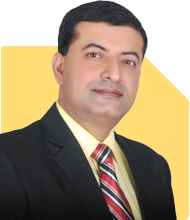Shekhar Kumar | Answer |Ask -Follow
Leadership, HR Expert - Answered on Apr 14, 2024
He has also mentored middle and senior management professionals for leadership positions and guided them in career development.
Shekhar has a bachelor's degree in business management from Magadh University, Bihar, and a master's degree in human resource management from Annamalai University, Tamil Nadu.... more

Hallo Sir, Myself Sanjay Agarwal. My daughter pursued her M.Sc. (physics) from Delhi University in 2010–11. But could not clear it and got back papers in two subjects. She joined the service as a teacher (TGT) in a reputed 10+2 school and, after that, got married. As she is also teaching the 11 and 12 standards (supposed to be taught by PGT) and the results of her students are extremely good, now she wants to complete her PG in Physics so that she may be allotted the class as PGT. Her school is also suggesting this to her, and they are ready to provide the necessary permissions for that. Please suggest that after 10–12 years of back papers in DU, is it possible to clear those back papers now? Or may you suggest alternatives so that she may complete her M.Sc. in Physics?
You may like to see similar questions and answers below
Aashish Sood |127 Answers |Ask -Follow
CAT, Management Expert - Answered on Jun 01, 2023
Maxim Emmanuel | Answer |Ask -Follow
Soft Skills Trainer - Answered on Apr 04, 2024
Patrick Dsouza |1428 Answers |Ask -Follow
CAT, XAT, CMAT, CET Expert - Answered on Apr 27, 2024
Dr Dipankar Dutta |1841 Answers |Ask -Follow
Tech Careers and Skill Development Expert - Answered on Dec 14, 2025
Nayagam P P |10854 Answers |Ask -Follow
Career Counsellor - Answered on Dec 14, 2025
Radheshyam Zanwar |6744 Answers |Ask -Follow
MHT-CET, IIT-JEE, NEET-UG Expert - Answered on Dec 14, 2025
Radheshyam Zanwar |6744 Answers |Ask -Follow
MHT-CET, IIT-JEE, NEET-UG Expert - Answered on Dec 14, 2025
Dr Dipankar Dutta |1841 Answers |Ask -Follow
Tech Careers and Skill Development Expert - Answered on Dec 14, 2025
Dr Dipankar Dutta |1841 Answers |Ask -Follow
Tech Careers and Skill Development Expert - Answered on Dec 13, 2025
Dr Dipankar Dutta |1841 Answers |Ask -Follow
Tech Careers and Skill Development Expert - Answered on Dec 13, 2025
Mayank Chandel |2575 Answers |Ask -Follow
IIT-JEE, NEET-UG, SAT, CLAT, CA, CS Exam Expert - Answered on Dec 13, 2025
Radheshyam Zanwar |6744 Answers |Ask -Follow
MHT-CET, IIT-JEE, NEET-UG Expert - Answered on Dec 13, 2025
Mayank Chandel |2575 Answers |Ask -Follow
IIT-JEE, NEET-UG, SAT, CLAT, CA, CS Exam Expert - Answered on Dec 13, 2025






















